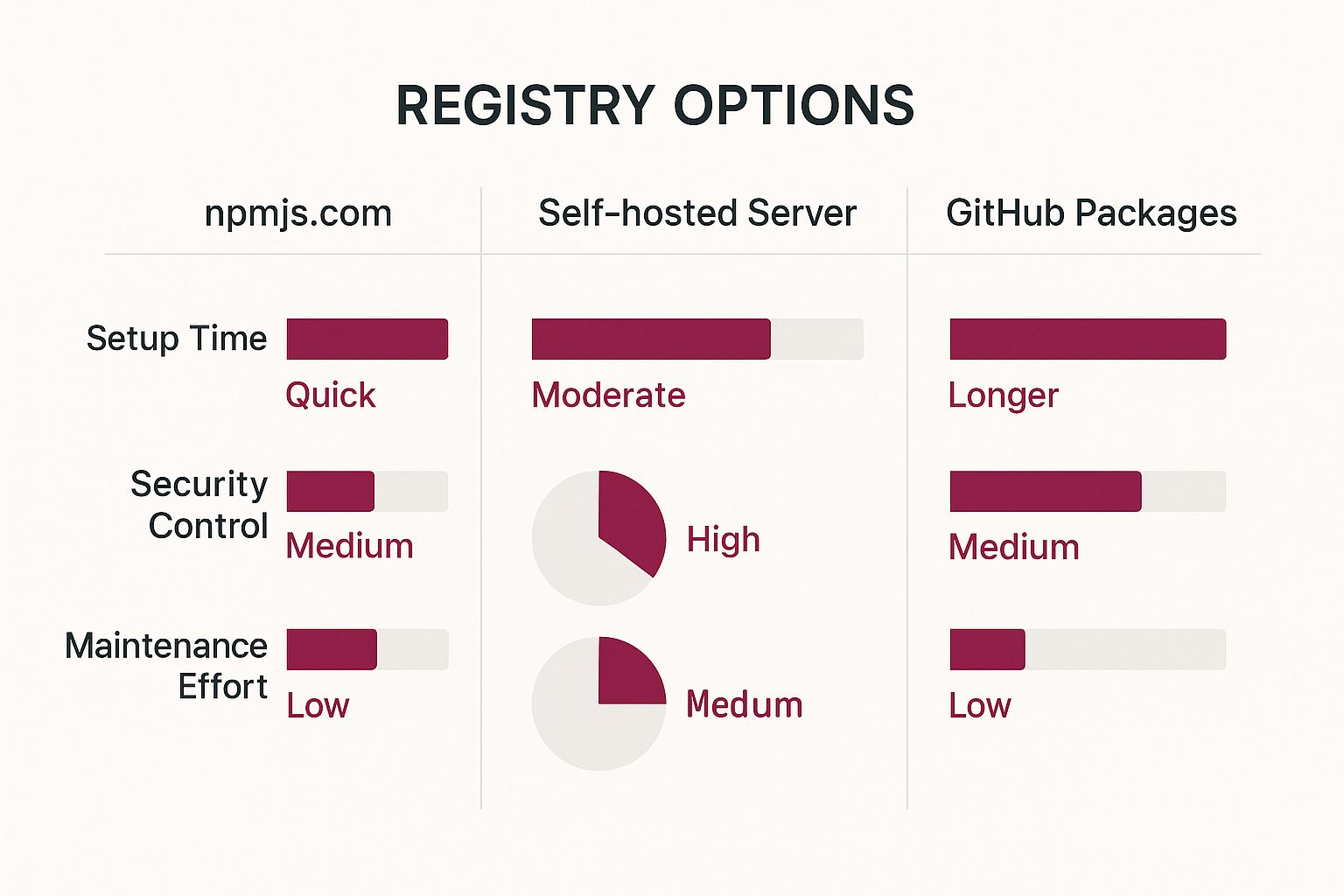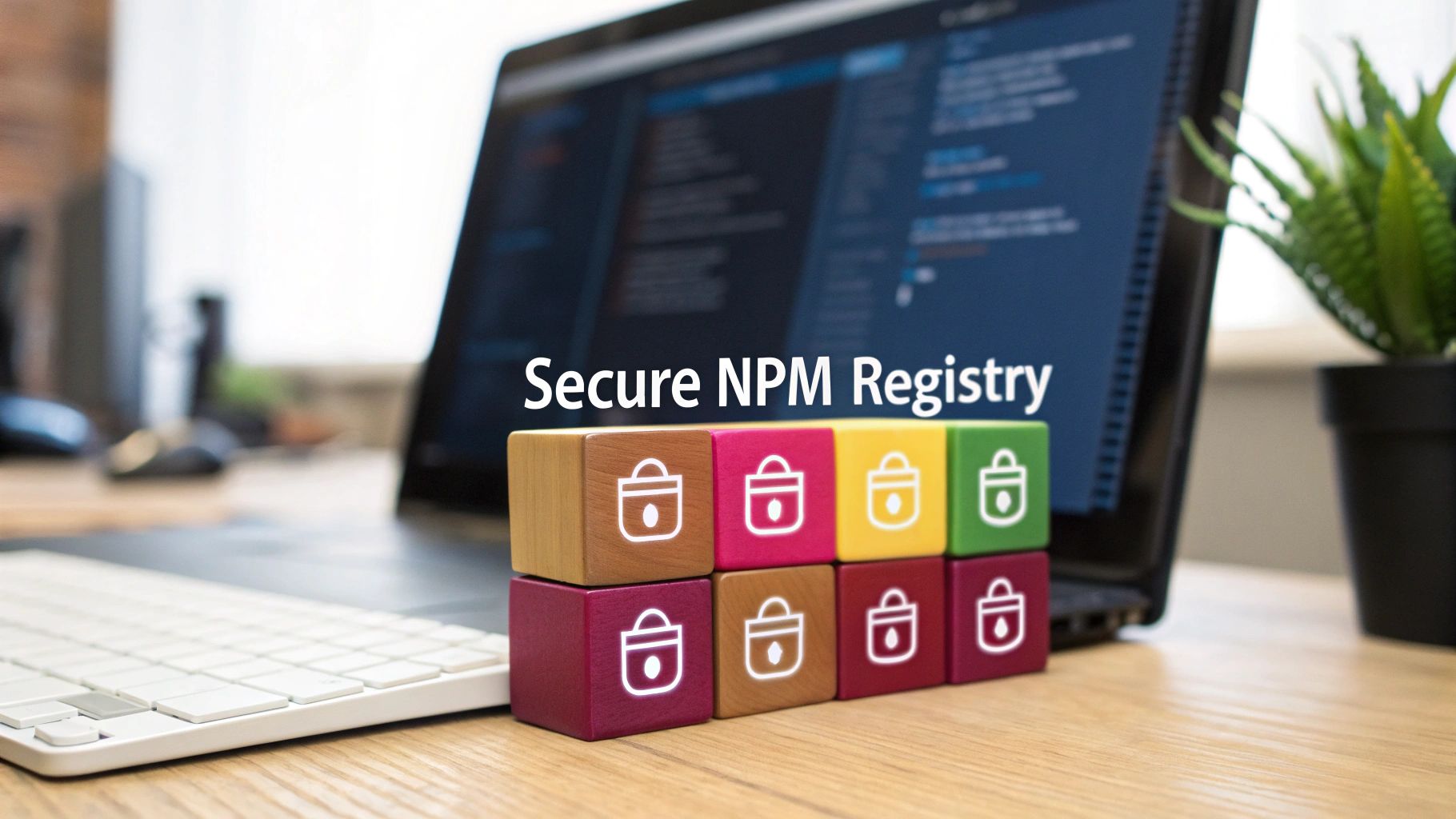A private npm registry is your organization’s secure vault for hosting proprietary packages. Unlike the public npm registry, which anyone can access, a private registry keeps your code locked down and only available to approved team members.
By running your own registry, you decide exactly which packages live inside your development ecosystem—and which stay out.
Understanding Your Private Code Library

Imagine strolling into a bustling public library: shelves stacked with books anyone can borrow or add to. That’s the public npm registry in a nutshell. It’s fantastic for community-driven modules, but you wouldn’t stash sensitive company blueprints on those open shelves.
Now picture a private library reserved strictly for your organization. Every title—your internal utilities, shared components, custom frameworks—is curated, maintained, and distributed from a single, secure location. That’s the essence of a private npm registry: a dedicated server acting as your single source of truth for all in-house code.
Key Roles Of A Private Registry
A private registry does far more than store packages. It becomes a cornerstone in your software supply chain, integrating seamlessly with broader processes like CI/CD and mirroring broader artifact management strategies in DevOps. Its top benefits include:
- Intellectual Property Protection: Keeps your secret algorithms and trade-secret logic off the public internet.
- Enhanced Security: Allows you to vet every package entering your builds, blocking anything malicious.
- Improved Performance: Caches popular public modules locally to speed up installs for developers and automation.
A private registry transforms package management from a public dependency into a controlled, internal asset. It’s the difference between leaving your blueprints in a public park versus securing them in a company vault.
As you lock down your codebase, you’ll also need to navigate licensing rules. Developers often ask how to handle open-source dependencies alongside proprietary work—start by exploring what is an open-source license for practical guidance.
In the end, a private npm registry delivers the stability, security, and speed that modern teams demand for reliable, professional software delivery.
Why Your Development Team Needs One

It’s easy to see the appeal of a private code library in theory, but its real value clicks when you see the day-to-day development problems it solves. Bringing a private npm registry into your workflow isn’t just an infrastructure tweak; it’s a strategic decision that directly boosts your team’s security, speed, and stability.
The most obvious win is a huge step up in security. Think of your private registry as a dedicated security gate for your entire software supply chain. You get to decide exactly which packages make it into your environment, which is your best defense against malicious code and dangerous dependency confusion attacks.
This control also helps you sidestep one of the most painful (and surprisingly common) mistakes: accidentally publishing proprietary code to the public. When you have a private registry, your internal packages stay internal by default. No accidents, no “oops” moments.
Accelerate Your Build Pipelines
Beyond locking things down, a private npm registry is a serious performance booster. When you cache public packages on your own server, you drastically cut down npm install times for everyone—both developers on their local machines and the automated build servers.
Instead of your pipeline reaching out to the internet for react or lodash every single time, it grabs them from a lightning-fast local source. This local caching also gives your automated workflows a critical safety net.
A private registry keeps your CI/CD pipelines running smoothly, even if the public npm registry goes down. That kind of reliability is gold, preventing an external outage from derailing your team’s entire development and deployment schedule.
For teams serious about optimizing their release cycles, this is a cornerstone. To see how resilient package management fits into the broader automation landscape, check out our guide on CI and CD practices.
Create A Single Source of Truth
Where a private registry really proves its worth is in team collaboration. It becomes the official, trusted home for all your internal libraries, shared components, and helper utilities. This simple change wipes out version conflicts and guarantees that every developer—from the seasoned architect to the new hire—is working from the same approved set of tools.
This unified, secure approach is why the market is growing so quickly. The global Package Registry Software market is on track to hit $180 million by 2025, driven by the absolute necessity for better dependency management in modern DevOps. As a company gets bigger, having that central registry is non-negotiable for keeping code consistent and high-quality. You can find more data on this growing market on DataInsightsMarket.com.
When you boil it down, a private npm registry brings clear, tangible benefits that you’ll feel every single day:
- Ironclad Security: You get full control over what code enters your projects.
- Blazing-Fast Builds: Watch your installation and build times shrink.
- Uninterrupted Workflow: Your team stays productive even when the public registry is down.
- Seamless Collaboration: One trusted source for all your internal code.
Comparing the Top Registry Solutions
Picking the right private npm registry isn’t just a technical choice—it directly impacts your team’s workflow, security posture, and ability to scale. There are several fantastic options out there, but the “best” one really comes down to your team’s specific needs, your current tech stack, and where you see your projects heading.
Let’s break down three of the most popular solutions: GitHub Packages, the seamlessly integrated choice; Verdaccio, the flexible open-source option; and JFrog Artifactory, the enterprise-grade powerhouse.
GitHub Packages: The Integrated Choice
If your team already lives and breathes in the GitHub ecosystem, GitHub Packages is the path of least resistance. It’s more than just a private npm registry; it’s a universal package manager that’s woven directly into the fabric of your source control and CI/CD pipelines.
The real magic is its native integration. You can link packages to repositories with zero friction, and all permissions are handled through the GitHub teams and access controls you already use. This tight coupling makes setup a breeze and cuts down on administrative headaches, making it a perfect starting point for many organizations.
Here’s a glimpse of how clean and intuitive it is to manage packages right inside the GitHub interface.

As you can see, every package is clearly tied to its source repository, which gives developers incredible traceability and simplifies their day-to-day work.
Verdaccio: The Flexible Self-Hosted Option
For teams that want total control without the overhead of a massive enterprise platform, Verdaccio is a brilliant open-source solution. It’s a lightweight, no-fuss private npm registry that you can spin up on your own infrastructure, whether that’s a server in your office or a private cloud instance.
Verdaccio’s biggest draw is its blend of simplicity and extensibility. You can get a basic registry up and running in minutes, but its plugin-based architecture means you can add custom authentication, new storage backends, and notifications as your needs grow.
This makes it an ideal fit for small-to-mid-sized teams who want the security of a private registry without a hefty price tag or operational burden. It gives you full ownership over your infrastructure, which is a huge plus for many modern DevOps teams. If you’re looking for more ways to streamline your processes, check out these essential automation tools for DevOps.
JFrog Artifactory: The Enterprise Powerhouse
When you’re dealing with a large organization and a complex software supply chain spanning multiple languages, JFrog Artifactory is the undisputed industry leader. It’s a true universal artifact repository manager, which means it handles your npm packages right alongside Docker images, Maven artifacts, Python packages, and pretty much anything else you can throw at it.
This universal approach creates a single source of truth for every component in your software ecosystem.
Artifactory is packed with advanced features like high-availability configurations, deep security scanning, and fine-grained access controls. It’s exactly this kind of robust, enterprise-ready solution that’s fueling the growth of the package registry market—a market where North America alone accounts for over 40% of global revenue. This highlights just how much value companies now place on platforms that can secure and manage their entire development pipeline.
Private NPM Registry Solution Comparison
To help you visualize where each solution shines, here’s a side-by-side look at their core strengths and differences.
| Solution | Type | Cost Model | Key Features | Best For |
|---|---|---|---|---|
| GitHub Packages | Managed (SaaS) | Usage-based (free tier included) | Native GitHub integration, CI/CD workflow simplicity, unified permissions. | Teams already heavily invested in the GitHub ecosystem. |
| Verdaccio | Self-Hosted | Open-Source (free) | Lightweight, highly extensible via plugins, full infrastructure control. | Small to medium-sized teams wanting control and flexibility without high cost. |
| JFrog Artifactory | Self-Hosted / Managed (SaaS) | Subscription-based (free tier available) | Universal artifact support, advanced security scanning, high-availability. | Large enterprises with complex, multi-language development environments. |
Ultimately, the best choice depends on where you fall on the spectrum of convenience versus control. GitHub offers unparalleled ease of use, Verdaccio provides ultimate flexibility, and Artifactory delivers enterprise-grade power.
Alright, let’s get our hands dirty and actually set up a private npm registry. Theory is great, but nothing beats seeing it work in practice. We’re going to use Verdaccio for this walkthrough. It’s a popular, lightweight, and open-source solution that’s perfect for getting started without a ton of hassle.
I’m a big fan of Verdaccio because you can get it up and running with literally zero configuration. It just works. It’s a simple Node.js application, which makes it super accessible whether you’re just playing around on your local machine or setting it up on a server for your whole team.
Step 1: Installing Verdaccio
First things first, you’ll need to install Verdaccio globally on your machine using npm. This will give you access to the verdaccio command from anywhere in your terminal.
Just pop open your terminal and run this:
npm install —global verdaccio
Once that’s finished, you can fire up the server immediately. Seriously, it’s this easy. Just type verdaccio and hit Enter. You’ll see some log output telling you the server is up and running, usually on http://localhost:4873. And that’s it—you officially have a private npm registry running on your machine.
Step 2: Configuring Your Registry
Okay, so it works out of the box, but you’ll probably want to tweak a few things to make it your own. The first time you run Verdaccio, it creates a config.yaml file in your home directory. This file is the control center for your registry, handling everything from user accounts to which public registries it talks to.
Go ahead and open that config.yaml file. You’ll see a few important sections:
storage: This simply points to the directory where all your private packages will be saved.auth: This is where you set up user management. The default uses a basichtpasswdfile, which is perfectly fine for getting started or for small teams.uplinks: This tells Verdaccio where to go when it needs to fetch a public package. By default, it’s already set to the official npmjs registry.packages: Here’s the important part. This section lets you define access rules—who can publish, install, or even see certain packages. You can lock down your private scoped packages (like@my-org/*) while leaving others open.
Tinkering with the
packagessection is how you bake security into your workflow. For example, you can set a rule that only authenticated team members can publish packages under your company’s scope, but anyone can install them.
Getting this configuration right is a cornerstone of a secure development process. A properly locked-down registry fits perfectly into a robust workflow, much like the ones discussed in this detailed CI/CD pipeline tutorial.
Step 3: Pointing Your NPM Client to Verdaccio
With your private registry humming along, the last piece of the puzzle is telling your local npm client to actually use it. You don’t want to cut yourself off from the public registry, you just want your machine to check your private one first.
Run this simple command in your terminal:
npm set registry http://localhost:4873/
From now on, whenever you run npm install, your computer will ask your local Verdaccio registry for the package. If Verdaccio doesn’t have it, it will automatically go out to the public npm registry, download it, save a copy for next time, and then pass it along to you. You get the best of both worlds: the security and speed of a private cache with full access to the entire public ecosystem.
Essential Security Best Practices

Think of your private npm registry as more than just a code library; it’s a security checkpoint for your entire software supply chain. But just having one isn’t a magic bullet. Its real power comes from setting it up correctly and actively hardening it against threats.
Getting this right protects your company’s secret sauce—your intellectual property—and keeps your development pipeline running smoothly.
The first step is moving beyond basic usernames and passwords. Your best friend here is access tokens. They act like temporary, single-purpose keys to your registry. You can generate them for specific developers or, even better, for your automated CI/CD pipelines. The best part? You can revoke a token instantly without messing up anyone’s main login credentials.
Implementing Granular Access Control
Once you’ve locked down who can get in, the next question is what they can do once they’re inside. This is where granular permissions become absolutely critical. A properly configured registry lets you set up very specific rules for different teams and processes.
For example, a common setup might look like this:
- Developers: Can read and install any package but can only publish new packages under their specific team’s scope (e.g.,
@billing-team/). - CI/CD Systems: Get a dedicated token that only allows publishing new versions of very specific packages. No more, no less.
- QA Teams: Can have read-only access across all internal packages to pull them down for testing.
This kind of fine-grained control is your best defense against accidental publishes or unauthorized code making its way into your private ecosystem.
Using scoped packages (like
@my-company/ui-kit) is non-negotiable. Scopes are your first line of defense against dependency confusion attacks, where a malicious public package tries to trick your system by mimicking the name of an internal one.
Proactive Vulnerability Scanning
Remember, your private registry doesn’t just hold your own code; it often caches public packages your teams depend on. This means a vulnerability in a public package is now sitting right inside your network. That’s why automated vulnerability scanning is a must-have.
Most modern private registries can hook directly into security tools that scan everything—your private code and your cached public dependencies—for known vulnerabilities. This turns your registry into a proactive security guard, flagging risks long before they have a chance to get into a production build. Integrating these checks is a huge part of a secure development pipeline. You can learn more about this by exploring these CI/CD security best practices.
Even public registries face a huge operational lift to stay secure. The official npm registry, now managed by GitHub, spends a fortune on data storage, transfer, and legal oversight just to maintain its integrity. When you run a private registry, that responsibility falls to you. To really button up your security, it’s worth brushing up on the top network security best practices for 2024.
Common Questions About Private Registries
As teams start thinking about setting up a private npm registry, the same set of practical questions always seems to pop up. Getting these cleared up early is the key to a smooth rollout and helps everyone see why this is a massive step up from simpler, less reliable methods. Let’s dig into the most common ones.
Can I Just Use a Private Git Repo Instead?
Technically, yes, you can point npm to a Git repo to install a package. But in practice, it’s a terrible substitute for a real private registry. Relying on Git for package management creates a lot of unnecessary headaches and completely misses the point of what makes a registry so powerful for professional teams.
A proper registry gives you semantic versioning. This lets you publish and depend on specific, unchangeable versions like 1.0.1 or 2.4.3, which is absolutely essential for creating predictable and repeatable builds. Git dependencies, on the other hand, usually just point to a branch or a commit hash. That’s a recipe for inconsistent installations and “it works on my machine” chaos.
Beyond that, a private registry is just plain faster. It serves up pre-packaged tarballs that are much quicker to download and install than cloning an entire Git repository every time. If you care about stability, speed, and clear dependency management, a private registry is the only way to go.
How Does a Private Registry Handle Public Packages?
This is where private registries really shine. They act as a smart proxy—or a cache—for the public npm registry. It sits right between your developers (and your CI/CD pipeline) and the wider internet, making your whole workflow faster and way more resilient.
It all happens seamlessly in the background. The first time anyone on your team requests a public package like react or lodash, your private registry intercepts that request. It goes out to the public npmjs.com, grabs the package, saves a copy locally, and then serves it to the developer.
From that point forward, every single request for that same version of
reactis served instantly from your registry’s super-fast local cache. This simple mechanism delivers two huge wins for your entire company.
First, performance goes through the roof. Running npm install becomes dramatically faster for everyone, especially for build servers that are constantly spinning up clean environments. Second, you get unbelievable reliability. If the public npm registry ever goes down, your builds keep running without a hitch using the cached packages. An external outage no longer has the power to stop your team in its tracks.
What Are Scoped Packages and Why Should I Use Them?
Scoped packages are the modern standard for organizing and protecting your internal code. You can spot them right away because they have a unique prefix, like @my-company/my-package. Making the switch to scopes is one of the most important things you can do to keep your internal packages clean, secure, and easy to manage.
The most obvious benefit is preventing name collisions. There are millions of packages on the public registry, so the odds of a generic, unscoped name like utils already being taken are basically 100%. Scopes give your organization its own private namespace, so you never have to worry about that again.
Even more critically, scopes are a major security feature. The npm client is designed to assume that any scoped package is private by default. This simple convention helps prevent developers from accidentally publishing sensitive, internal code to the public. Using unscoped, “global” names for your private packages is an old, risky habit that leaves you wide open to dependency confusion attacks and just makes a mess of your codebase.
To put it bluntly: if you’re serious about building a secure and scalable internal package strategy, using scopes isn’t optional.
Accelerate your React Native app updates and eliminate app store review delays with CodePushGo. Our platform offers secure, over-the-air code deployments that get your bug fixes and new features to users in minutes, not days. Explore how instant, reliable updates can transform your development cycle at https://codepushgo.com.




